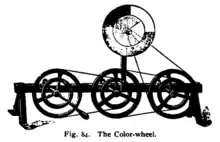Color wheel (optics)
A color wheel or other switch for changing a projected hue (e.g., for an optical display) is a device that uses different optics filters or color gels within a light beam. Common usage includes continuously-rotating wheels for seasonal home displays (e.g., at Christmas) and controllable color wheels for a particular instrument (e.g., SeaChanger Color Engine for stage lighting), while non-wheel devices include scrollers and semaphore types with lever arms (e.g., on the 1897-1917 Grand Army Plaza fountain).


In projectors
A common application of the color wheel is to provide a color filter for a single-chip projector, which would otherwise only be able to display a greyscale image. The color wheel is placed in front of the light source (usually a metal-halide lamp) and spins rapidly, splitting the light into red, green, and blue primary colors. The chip then displays each primary color one at a time, quickly enough that the human eye will see them as a full-color image. This method is not perfect; in high-contrast scenes, such as a bright streetlight against a night sky, or the credits at the end of a film, the individual color frames may be visible; therefore, high-end and professional projectors split the light with a prism and use three separate chips, one for each primary color.

References
External links
 Media related to Color wheel (optics) at Wikimedia Commons
Media related to Color wheel (optics) at Wikimedia Commons